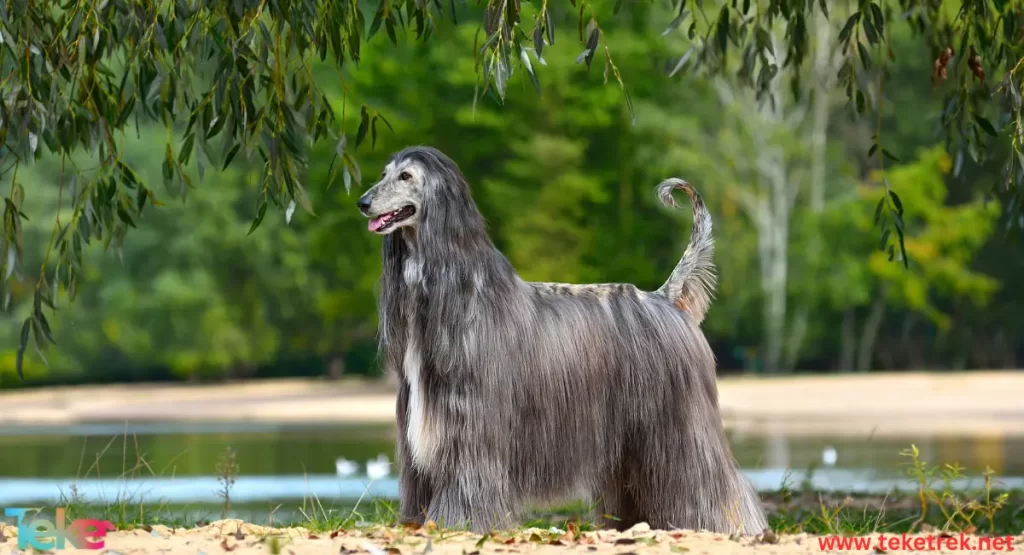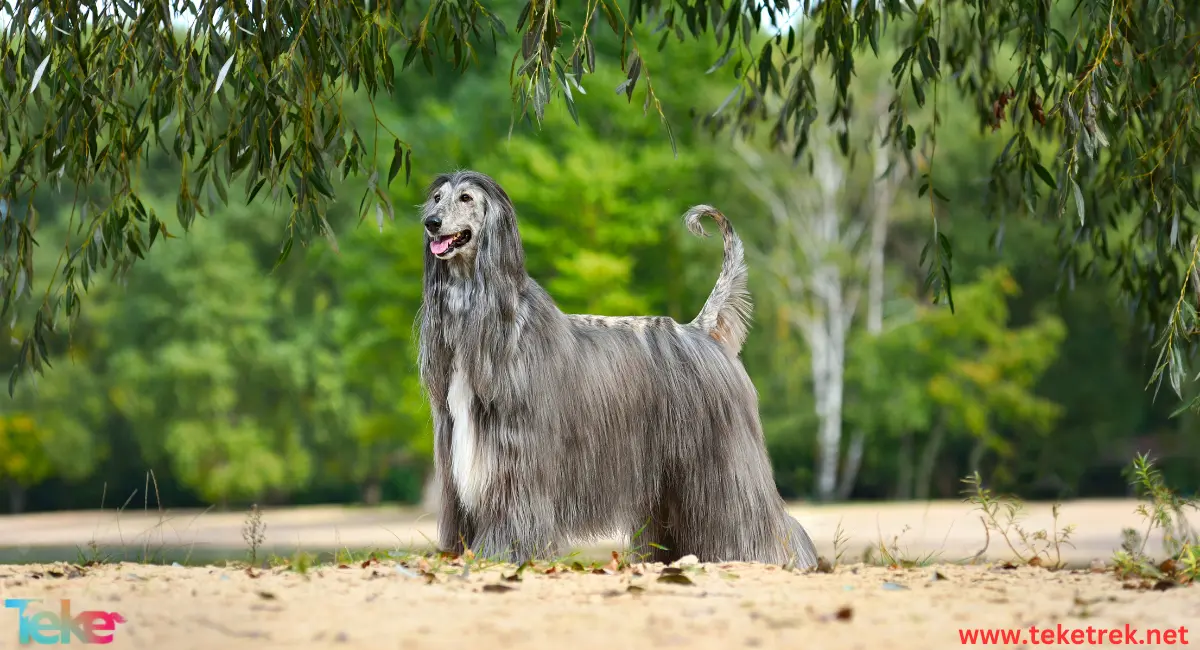The Afghan Hound is one of the oldest and purest dog breeds in the world, and the most prominent of the distinctive breeds found in the mountains of Afghanistan and the Hindu Kush, whose historical roots extend back thousands of years BC.
The Afghan Hound is called the king of dogs and is known in the local Afghan language as the Tazi Spi.
He is known for his attractive style and thick hair, which gives him more beauty and makes it easier for him to adapt to life in mountainous areas that need thick cover.
In this article on TekeTrek website, we will learn together about the Afghan dog in terms of history, food, specifications, and many other important details. All you have to do is devote some time to learning the most important information related to it.

The history of the appearance of the Afghan Hound
- Many studies have studied the history of the appearance of the Afghan dog, but to this day no specific time has been agreed upon, but we can say that its actual appearance began approximately 200 years ago. The Afghan Hound was first identified in Europe when a number of English officers arrived on the Indo-Afghan border, but most of them died of hunger due to World War II, which led to a lack of food resources and a lack of breeding.
- Afghan hounds returned to breeding after many mountain and desert species were imported to England and Scotland. The Americans then imported some species from Britain in 1926, when the Afghan hound breed was recognized for the first time by the American Kennel Club. The Afghan Hound Club was formed in 1926. 1937.
- Many also attribute the history of the Afghan Hound to some ancient civilizations, such as the Babylonian civilization and the Sassanian civilization in Iran, where it was considered a symbol of luxury and beauty.
- The Afghan Hound has also been seen in many Middle Eastern cultures, embodied in ancient paintings and traditional arts.
What are the characteristics of the Afghan Hound?
The Afghan Hound has a set of physical characteristics that reflect a unique and unparalleled elegance and luxury. the most important:
- The Afghan Hound is known for its speed, covering distances of at least 35 and 40 miles per hour.
- The Afghan Hound can jump a great distance of up to 20 feet at a rate of 7 feet in a straight line while assuming a standing position.
- The height of the Afghan Hound reaches approximately 70 cm, and males are usually taller than females.
- The weight of the Afghan Hound ranges between 23 and 27 kg.
- The Afghan Hound has a long, thin nose that ranges in color from brown to black, and it also has large, drooping ears.
- The Afghan Hound has a thin, upright tail with a slight curve at the tip.
- The Afghan Hound is distinguished by its stunning, long, soft, silky coat.
- The Afghan Hound has eyes with dark irises and a slit that appears almond-shaped. It also has large paws.
- The Afghan Hound has more prominent hips than other types of dogs, which helps it chase and hunt in various rugged and mountainous terrains with ease.
- The Afghan Hound’s rib cage is very wide, and its depth ensures that the heart muscle and lungs work without interruption.
- The Chinese Terrier comes in all colors with white spots on the face, the most common being black and red.
- The average lifespan of the Afghan Hound is between 12 and 14 years.
- The Afghan Hound has a strong sense of sight that allows it to see things from a long distance, and the necks of these dogs also help their heads twist to see what is around them well.
- The Afghan Hound can perform field sweeps up to about 270 degrees, thanks to the structures of its heads that help it see from several angles.
The physical features that the Afghan Hound
Characterized by many personality and temperamental traits, the most prominent of which are as follows:
- Although the Afghan Hound is not aggressive and does not fear humans, it is somewhat aloof and does not adapt easily to people outside its family.
- The Afghan Hound has a great deal of unruliness, and if any task is entrusted to him, he will carry it out with great commitment and seriousness to the point of harm.
- The Afghan Hound has a high degree of intelligence, but it does not respond to commands immediately. It needs a little patience, as it is independent in thinking.
- The Afghan Hound does not tend to compete with other dogs, but rather only wants to prove himself while hunting and tracking prey.
- The Afghan Hound is a high-class sporting animal, and it is capable of giving you an enjoyable sporting show.
- The Afghan Hound is a loyal friend to its owner to the point that it shows a great understanding of his feelings and needs.
- The Afghan Hound needs daily training for at least 40 minutes.
Health problems that the Afghan Hound is exposed to
The Afghan Hound has less natural fat stores, which requires a lot of caution when wanting to perform surgery on it due to its high sensitivity to anesthesia. The following are some tests that must be followed up on an ongoing basis:
- Vision examination
- Conduct an assessment of the health of the pelvic bones
- Thyroid test
As for the diseases that he may suffer from, he is one of the breeds susceptible to hip dysplasia, the symptoms of which are arthritis in the hip area, but unfortunately it is one of the diseases that cannot be treated.
Cataracts are one of the diseases that the Afghan Hound suffers from, especially when they get older. Surgery can be done for this, but it is preferable not to do it as they can live in peace to the same extent.
It is also possible to suffer from entropion, which is the turning of the eyelashes and eyelids.
Preferred diet for the Afghan Hound
- The Afghan Hound is one of the animals that does not like to eat much, as it is preferable to obtain high-quality dry food such as protein and vegetable oil, as it is supposed to eat between 2 and 2 and a half cups of dried food daily, divided into two meals.
- But you should avoid feeding him fatty, fried, and spicy foods, and not give him pork, sweets, or foods that contain artificial additives.
- Young Afghan Hounds and older ones who suffer from any injury or health problem require different food needs, so it is very important to adhere to the instructions of a qualified veterinarian to determine the appropriate diet, knowing that experts recommend reducing the amount of food and increasing exercise for adult dogs who suffer from obesity. In weight.
Some tips for caring for the Afghan Hound
Raising an Afghan Hound is one of the best options to have an agile and fun friend, but maintaining it requires special tips to care for it:
- The coat should be kept clean on a regular basis to prevent tangles or mats.
- You can comb the fur several times a week in order to maintain a soft, silky texture, because this helps reduce the amount of hair loss.
- You should trim your Afghan Hound’s nails regularly, especially when it starts to bother him while moving around.
- Pay attention to dental hygiene regularly, at least twice a week.
- You should dry his cast immediately after bathing to keep his coat tidy for as long as possible.


FAQs about the Afghan Hound
There are many common questions that interest users about the Afghan Hound. Here are the most important of these questions and their answers:
- What does a hound hunt?
This type of dog is distinguished by its ability to hunt prey with speed, agility, and flexibility.
- Are Afghan hounds expensive?
If you buy it from a breeder, you will buy an average of 1,000.
- Are Afghan dogs’ good pets?
Yes, they make great family dogs in their friendly and loving nature.
- Do Afghan hounds have hair or fur?
they have thick, silky hair.
In conclusion, the Afghan hound is a beautiful addition to your home that gives you a lot of entertainment and enjoyment, as it is a lively companion who loves activity and sports.
If you are a fan of hunting, the Afghan Hound is an ideal choice for you to enjoy enjoyable hunting trips, as it is a first-class skilled pursuer and an unparalleled skilled hunter who can easily pounce on any prey






